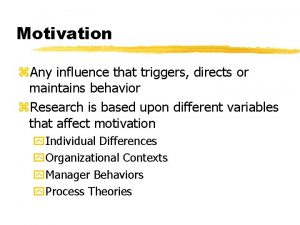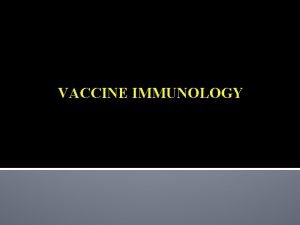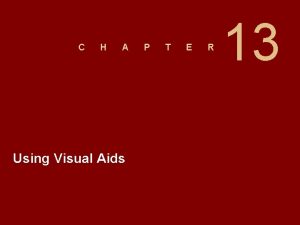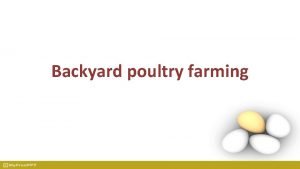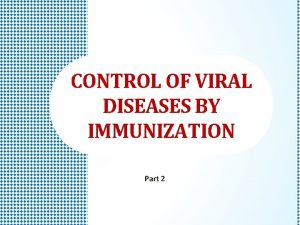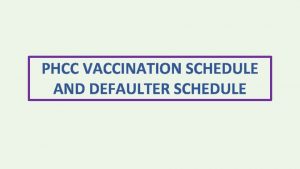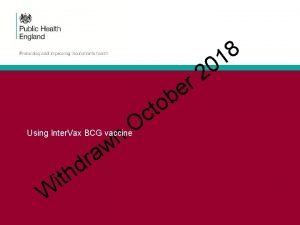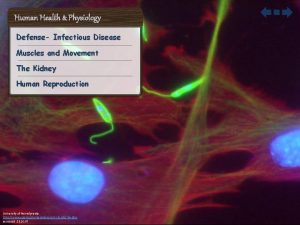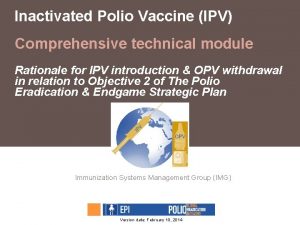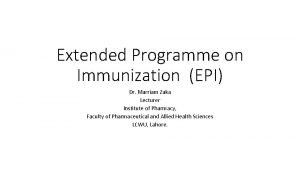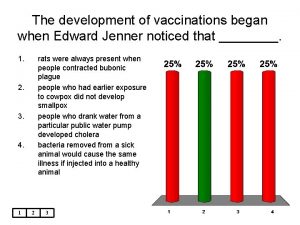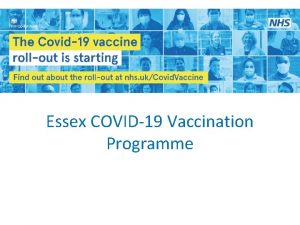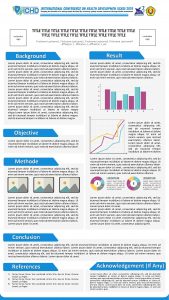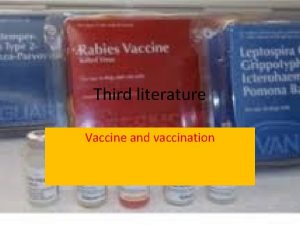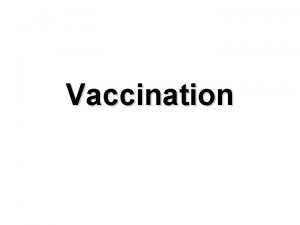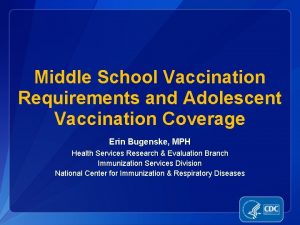Title Trends and patterns of Vaccination inequity In

















- Slides: 17

Title: Trends and patterns of Vaccination inequity In Ethiopia: Opportunities and Challenges to improve Coverage and inequity 21 th ARM, Immunization side meeting October 15 -18, 2019 Addis Ababa, Ethiopia.

Outline of Presentation • Background information • Why addressing immunization equity is important? • Equity during MDG & SDG • Inequity patterns and status of vaccination in Ethiopia • Benefit of Equitable Immunization service • Opportunities and Challenges to improve coverage and inequity • Discussion points

What is equity ? • Equity is the absence of avoidable or remediable differences among groups of people, whether those groups are defined socially, economically, demographically, or geographically (WHO) • Equity involves (a) political and ideological issues i. e. legislation, policy, governance, accountability, etc. issues that are not favouring equal opportunities for the disadvantaged children and communities (b) services and systems i. e. services that are not reaching those who are most in need. This requires analysing and removing the barriers to access and underlying systems constraints (c) societal factors i. e. social norms, behaviours, practices that are impeding access to services or fuelling discrimination and deprivations

Background information- immunization • Full immunization is an effective public health intervention to reduce child morbidity and mortality • Increasing immunization coverage is a key government priority to meet the performance indicators of the HSTP and SDG 3 targets • Immunization is both a driver of equity and a key indicator of health equity given that children missing out on immunization are likely to suffer multiple deprivations. • Immunization is a cross-cutting health intervention (provided across the life-course and the levels of care) • But to move towards equitable health outcomes, we need to know: ØWhere are the inequities? Which population groups are disadvantaged? ØWhy are the large gaps in coverages between the disadvantaged and advantaged groups despite vaccination is a cost-exempted service? • This information is critical to design appropriate policies to address health equity.

Why is addressing immunization equity important ? • Equity in immunization is critical because the poorest population bear the largest burden of vaccine preventable diseases. Investing in the most deprived children saved twice more lives compared with similar investment in less deprived communities. (UNICEF Narrowing the Gap, July 2017) Global and National priority • Global Goals: o GVAP- Goal 3 - benefits of immunization are equitably extended to all people o SDG 10 - “ living no one behind” and SDG reducing inequities within and among countries o Addis Ababa Action points African ministers Summit on immunization which took place from 24 to 25 February 2016 o Target 3. 8 of the SDG achieving Universal health coverage including financial protection • Nationally in Ethiopia HSTP (2015/16 -2019/20): equity has been given priority and it is one of the transformational agenda of the health sector

Equity during SDG era A well-recognized shortcoming of the MDG was the failure to target equitable distribution of benefits while focusing on raising national averages. Therefore, SDGs recognize the critical importance of disaggregating data and using for the planning and action; 1. equity being counted– looking beyond national averages e. g. who, where, and why children are still being left behind. 2. equity in quality it is not enough only to close equity gaps in access to health services for children. finding new ways to provide high quality services is critical to ensure equity in real sense. 3. equity in resilience. There is no doubt that humanitarian emergencies disproportionately affect the most disadvantaged children. E. g. effects of conflict and drought increase the risks for those disadvantaged groups. Therefore, a special focus on such group of children is critical to achieve equity.

Inequity status of vaccination in Ethiopia • Vaccination coverage has moderately increased. However, the increase was not in line with the increase in health facilities and human resources. FIC increased by three folds while HFs increased by more than 10 folds during the last two decades • Almost a comparable proportion of children in the country have “not been vaccinated at all” from 2010 & 2019 (15 to 20 percent) • There are wide variations in coverage amongst different regions • Economic status, care takers’ educational status, place of residence, and geographic distribution were major equity factors for vaccination inequality in Ethiopia • Particularly, inequality gap was widened between the poorest and wealthiest households • Poor and illiterate caretakers being discouraged from using and returning for vaccination services. This directly implies for utilization of other RMNCH services resulting into poor outcomes.

What is being done to reduce inequity in Ethiopia? • The government has pro-poor policies and strategies while challenged by implementation capacity • The government is working to reduce geographic inequality through provide special support for low performing administrative and geographic areas • The FMo. H and partners conduct annual and periodic state of inequality to monitor the status • Expand service availability for example through procurement and installation of SDDs in remote health facilities • Strengthen community platform WHDA/Social mobilization committee • Targeted support by partners • RED/REC and PIRI initiatives to reach unreached

Proportion of penta 3 Coverage EDHS 2016 vs Mini DHS 2019 by Region Percentage coverage 120 Chart Title 100 80 60 40 20 0 Tigray -20 Afar Amhara Oromia Pentavalent 3 EDHS 2016 Somali Ben-Gum SNNPR Pentavalent 3 EDHS 2019 Adminstrative regions Gambella Harari Addis Ababa Dire Dawa Difference from 2016 to 2019 National

Trend and pattern of immunization inequality for different antigens between highest and lowest economic status, uneducated and secondary+ and urban rural residents from 2000 -2019 DHS

DPT/penta 3 coverage trend - Year 2000 - 2019 Large differences in various data sources 110 100 95 86 70 60 46 42 40 30 60 52 50 72 66 66 56 36 32 95 87 82 79 80 61 59 53 37 30 21 20 Survey EDHS Mini-DHS WUENIC Admin 2019 2018 2017 2016 2015 2014 2013 2012 2011 Year 2010 2009 2008 2007 2006 2005 2004 2003 2002 0 2001 10 2000 % Coverage 90

Benefit of Equitable Immunization service • Immunizations is a tracer primary health care service: where vaccines are delivered, so are other child health services; such as GM, nutrition counseling and treatment, Immunization services can; • Be used as tracer and driver for ensuring child health equity and for revitalizing PHC for UHC • Create systems for reaching households/family oriented preventive and promotive services such as hygiene messages, ODF (h-hs sanitation), ITN use, FP etc • Contribute to over all strengthening of the health system • Enhance interoperability in birth notification for registration and use of data from CRVS • One of the key responses during humanitarian situation

Opportunities to improve coverage and inequity • High Political commitment • Existence of Favorable policies and strategies • Transformation agendas that have synergetic effect four in one • Extensive expansion of PHC , well defined and structured health system • Existence of community platform and Experience in using Community platform and community mobilization • Defined and adaptable strategy from global to local and Forty years of experience on EPI • Immunization is exempted service and can be provided at all level of health care and using different approaches • Existence of Partners support • Favorable platform for integrated programming and service delivery

Challenges to improve Coverage and Inequity Demand • Fatigue from (HDA/WHDA)- a net work of community volunteers declining density and engagement • Fear of too many injections at a time and side effects leading to vaccine hesitancy among care takers to withdraw vaccination • Care taker not informed and/or forgot when to come back for the next appointment • Low Socio-economic status led to inadequate information and prioritization to demand right to vaccination, Migration (movement) Supply side barriers • Stockout of vaccines at the point of service delivery, inadequate cold chain maintenance, • Turnover of trained staff, low commitment and accountability, inadequate use of data and evidence for decision • Topographic, Geographic and social distance, Missed opportunities • Session interruption and frequent closure of HPs and frequent appointment for multidose vaccines

Challenges to improve Coverage and Inequity… Enabling environment • Lack of knowledge, skill and positive attitude on Programme management , minoring, coordination and accountability • Inadequate budget allocation for outreach services • Rapidly expanding/evolving scope of EPI vs health system capacity to carry out tasks (increase NVI, SIA, Budget, cold chain capacity, eradication, elimination activities) • Ensuring effective service delivery in conflict-affected, settings with limited capacity and weak systems; • Reaching deprived populations in urban slums; remote, inaccessible populations; • Securing sustainable financing for immunization programmes, Quality • Poor data quality, inaccurate denominator • There is no cohort registry and defaulter tracing and referral mechanism

Discussion points • Why is vaccination coverage and inequity lingering despite favorable conditions and opportunities exist in Ethiopia? • What actions can be taken to improve coverage and equity of vaccination? • How do we do these actions? • Who and when shall the actions be done? • How can we ensure that actions are being taken?

I Thank you
 Class inequality
Class inequality Underreward inequity
Underreward inequity Micro inequity exercises
Micro inequity exercises Shine skis encapsulated
Shine skis encapsulated A visual aid used to show statistical trends and patterns
A visual aid used to show statistical trends and patterns A visual aid used to show statistical trends and patterns
A visual aid used to show statistical trends and patterns Poultry vaccination schedule
Poultry vaccination schedule Vaccination schedule in palestine
Vaccination schedule in palestine Dog vaccination perry county
Dog vaccination perry county Defaulter vaccination schedule
Defaulter vaccination schedule Vaccination bruxelles
Vaccination bruxelles Mandatory vaccination
Mandatory vaccination Vaccine vial monitors
Vaccine vial monitors Oogenesis defination
Oogenesis defination Ipv vaccine
Ipv vaccine Newborn baby vaccination chart with price in pakistan
Newborn baby vaccination chart with price in pakistan A vaccination for smallpox was developed in 1796 by ____
A vaccination for smallpox was developed in 1796 by ____ Encephalitis lethargic
Encephalitis lethargic

